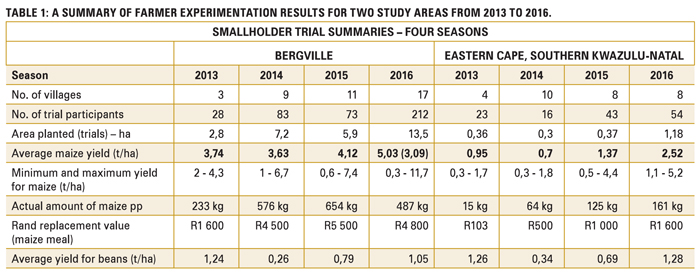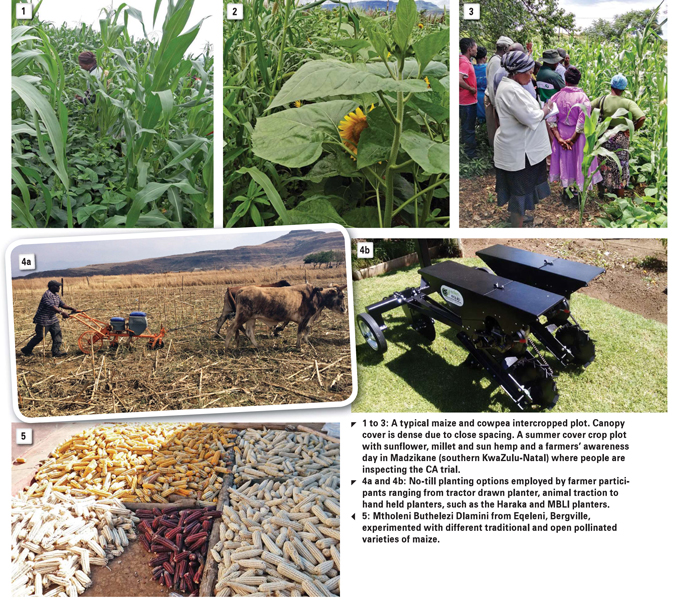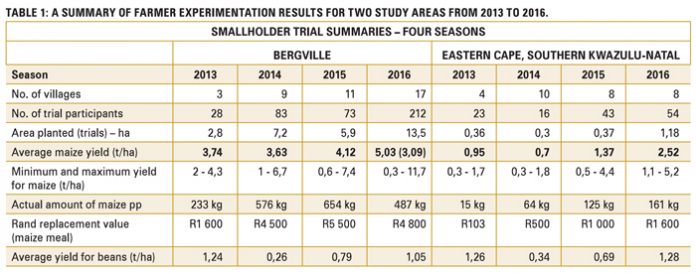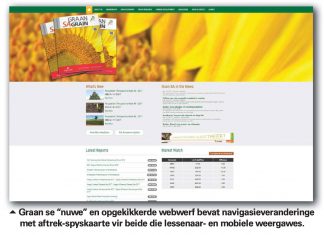January 2018
ERNA KRUGER, director, Mahlathini Development Foundation and DR HENDRIK SMITH, conservation agriculture facilitator, Grain SA
One of the main aims of the Conservation Agriculture (CA) Farmer Innovation Programme (FIP), which is implemented by Grain SA and funded by The Maize Trust, is to understand, improve and facilitate the implementation of CA in smallholder farming systems in South Africa.
Through this process the programme expects to achieve significant improvements in natural resource status and quality, allowing sustained crop production intensification.
The farmer-centred innovation systems research process underpinning the programme is based on working intensively with farmer learning groups and local facilitators to scale out CA in and between selected villages and study areas.
Within the learning groups, farmer innovators volunteer to set up and manage farmer-managed adaptive trials in their backyards or fields. These plots become the ‘learning venues’ for the whole learning group.
Farmer field school and action research methodologies are used within the group to focus the learning on the actual features and changes in the field throughout the season, such as growth and development of the crops and soil health. The new CA practices are tested against the ‘normal’ practice in the area as the controls.
During frequent learning events or workshops, farmers observe, analyse and assess what is happening in the trials and discuss appropriate decisions and management practices in view of continuous adaptation. Short information provision and training sessions (e.g. on special topics) are included in these workshops.
Building of social and financial capital are enhanced by also supporting the formation of local level micro savings and loan associations and by supporting the development of localised farmer centres. The latter facilitates bulk buying of inputs, setting up of localised milling and marketing operations.
The adaptive trials are also used as a focus point for the broader community to engage through local learning events and farmers days. Stakeholders and the broader economic, agricultural and environmental communities are drawn into these processes and events. Through this, innovation platforms are developed to improve co-operation and synergy between programmes, and development of appropriate and farmer-led processes for economic inclusion. These innovation platforms also provide a good opportunity to focus further research on the ‘needs’ emerging through the process.
The trials are undertaken on a small portion of the smallholders’ plot and range in size between 100 m2, 400 m2 and 1 000 m2 depending on their scale of farming. Different modes of planting are accommodated, such as hand planting, animal traction and tractor drawn planting options, which are further supported with the provision of appropriate implements. Participants also pay a subsidy towards the input requirements for their trials.
In addition, research plots, managed jointly by field staff (researchers) and farmers are set up to glean information on more technical aspects such as infiltration, water holding capacity, productivity and soil health.
The basic protocol for planting farmer-led CA trials in the first season includes: Intercropping with narrow maize tramlines (2 rows, 50 cm row width) and legumes (20 cm between rows x 10 cm in the rows), use of a variety of open pollinated and hybrid seeds, rotations between maize and legumes, weed control through a combination of pre-planting spraying with herbicides and manual weeding during the planting season and pest control using generic pyrethroid-based formulations, sprayed once at planting and once at top dressing stage.
In the following seasons, depending on the farmer level analysis, they undertake a number of different experimental options including:
- Different varieties of maize (white, yellow, open pollinated,hybrid)
- Different varieties and types of legumes
- Early planting
- Manure and fertiliser combinations
- Targeted fertility regimes and pest control measures
- Intercropping versus crop rotation options
- Summer and winter cover crops
- Mulching
- Organic options
By the fourth iteration or season of experimentation, the farmers choose their own experimentation protocols.
Over the four years that this programme has been active, the number of participants and areas involved have systematically increased and improved, as have yields, soil health and livelihoods. Table 1 indicates the expansion (scaling out in both areas) from seven villages in 2013 to 25 villages in 2016. Trial participants have increased from 52 to 266 and average yields for maize have almost doubled.

In the 2017/2018 season a total of 360 farmer-led trials will be established allowing for a further scaling out of CA through this innovation systems process.
In the face of land degradation and poverty, this process has already proven to yield enormous potential to provide much needed solutions and opportunities for smallholder livelihoods dependent on rainfed crop production systems.
In the next two articles on CA and smallholders, two case studies will be presented on smallholder farmers who have successfully adapted their cropping systems with CA principles, leading to much higher levels of sustainability and resilience.

Publication: January 2018
Section: Grain SA


















